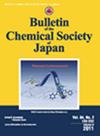Development of Hyperpolarized NMR Molecular Probes for Biological Applications
IF 3.8
3区 化学
Q2 CHEMISTRY, MULTIDISCIPLINARY
引用次数: 1
Abstract
Our bodies are composed of molecules. The dynamic activity of molecules is the essence of living phenomena. Toward the analysis of this, the establishment of in vivo molecular imaging techniques has been sought. Hyperpolarized nuclear magnetic resonance (NMR) is a promising technique that enables in vivo molecular imaging using highly sensitive hyperpolarized NMR molecular probes and is expected to be a next-generation molecular imaging technology. However, a major challenge lies in the rapid relaxation of the hyperpolarized nuclear spin state of the molecule, i.e., a short lifetime of high sensitivity. We have made our efforts to address this critical issue. This award account mainly describes our research to develop hyperpolarized molecular probes with long hyperpolarization lifetime. Based on the understanding of the relaxation mechanism of hyperpolarized spin states, we successfully developed various hyperpolarized 13C molecular probes, some of which were applied for in vivo studies. In addition, we demonstrated the development of hyperpolarized 15N molecular probes with remarkably long hyperpolarization lifetimes. These results pave the way for the rational design of hyperpolarized molecular probes, which has been difficult to achieve so far. Hyperpolarized nuclear magnetic resonance is a promising technique for in vivo molecular imaging. Based on the understanding of the relaxation of hyperpolarized spin states, we developed various hyperpolarized molecular probes, some of which were applied for in vivo studies. These results pave the way for the rational design of hyperpolarized molecular probes, which has been difficult to achieve so far.生物超极化核磁共振分子探针的研究进展
我们的身体是由分子组成的。分子的动态活动是生命现象的本质。为了分析这一点,人们寻求建立体内分子成像技术。超极化核磁共振(NMR)是一种很有前途的技术,它可以使用高灵敏度的超极化核磁共振分子探针进行体内分子成像,有望成为下一代分子成像技术。然而,一个主要的挑战在于分子的超极化核自旋态的快速弛豫,即高灵敏度的短寿命。我们为解决这一关键问题作出了努力。本获奖报告主要介绍了我们在开发超极化寿命长的超极化分子探针方面的研究。基于对超极化自旋态弛豫机制的理解,我们成功开发了多种超极化13C分子探针,其中一些已用于体内研究。此外,我们还展示了具有超长超极化寿命的超极化15N分子探针的开发。这些结果为合理设计超极化分子探针铺平了道路,这是迄今为止难以实现的。超极化核磁共振是一种很有前途的体内分子成像技术。基于对超极化自旋态弛豫的认识,我们开发了各种超极化分子探针,其中一些应用于体内研究。这些结果为合理设计超极化分子探针铺平了道路,这是迄今为止难以实现的。
本文章由计算机程序翻译,如有差异,请以英文原文为准。
求助全文
约1分钟内获得全文
求助全文
来源期刊
CiteScore
6.40
自引率
5.00%
发文量
194
审稿时长
3-8 weeks
期刊介绍:
The Bulletin of the Chemical Society of Japan (BCSJ) is devoted to the publication of scientific research papers in the fields of Theoretical and Physical Chemistry, Analytical and Inorganic Chemistry, Organic and Biological Chemistry, and Applied and Materials Chemistry. BCSJ appears as a monthly journal online and in advance with three kinds of papers (Accounts, Articles, and Short Articles) describing original research. The purpose of BCSJ is to select and publish the most important papers with the broadest significance to the chemistry community in general. The Chemical Society of Japan hopes all visitors will notice the usefulness of our journal and the abundance of topics, and welcomes more submissions from scientists all over the world.

 求助内容:
求助内容: 应助结果提醒方式:
应助结果提醒方式:


